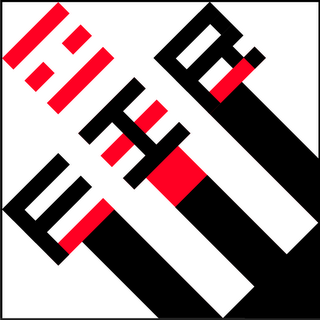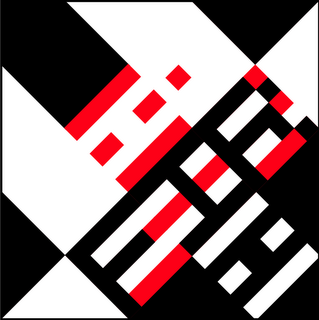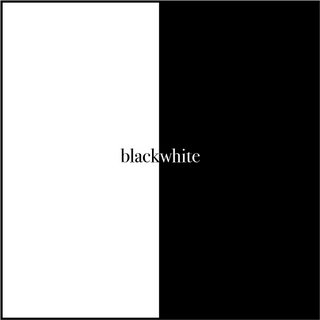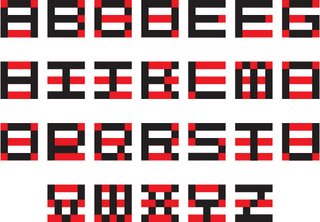Saturday, September 30, 2006
Thought of water, [kan], North...

1, tasteless, odorless, colorless to the naked eye
None, transparency, different from micro and macro
2, Forms of life
Important, basic element, live
3, Universal solvent
Merge, transform to tastable, smelly, colorful
4, Exist everywhere
Full, isolation, mixed, transformation
5, high surface tension (stays together as drops)
Connection, imply, contrast, united, dot-to-line, area
Wednesday, September 27, 2006
Tuesday, September 26, 2006
Thought of positive & negative, part two

The strongest argument to support the reversal of positive shape and negative shape will be the symbol of I-Ching, Bagua, which as shown below. This ancient Chinese system of cosmology and philosophy centers on the idea of the dynamic balance of opposites, the evolution of events as a process, and acceptance of the inevitability of change. This symbol tells the subtle relationships between positive shape and negative shape.
Thought of figure & ground
To discuss the relationship between positive and negative shapes, we should define what is shape exactly.
A shape is created when:
1, A line connects to enclose an area
2, An area of color or texture is defines by a clear boundary
3, An area is surrounded by shapes.
When shape type one, or type two is created, which is positive shape, type 3 shape is created automatically, which will be the negative shape around.
The argument is about the relationship between the positive shape and negative surrounding. As we know, when the positive shape which is figure, and negative shape which is ground, are equally well designed, the shapes becomes engaged.
Sometimes positive shape and negative shape engage to create anther kind of force, which is figure/ground reversal. Depends on how designer compose the size, position, value, volume of the shapes, and also depends on reader’s personalities, sometimes positive shape becomes focal point, and sometimes negative shape becomes focal point, which makes it become positive, or figure, while positive shape becomes ground.
A shape is created when:
1, A line connects to enclose an area
2, An area of color or texture is defines by a clear boundary
3, An area is surrounded by shapes.
When shape type one, or type two is created, which is positive shape, type 3 shape is created automatically, which will be the negative shape around.
The argument is about the relationship between the positive shape and negative surrounding. As we know, when the positive shape which is figure, and negative shape which is ground, are equally well designed, the shapes becomes engaged.
Sometimes positive shape and negative shape engage to create anther kind of force, which is figure/ground reversal. Depends on how designer compose the size, position, value, volume of the shapes, and also depends on reader’s personalities, sometimes positive shape becomes focal point, and sometimes negative shape becomes focal point, which makes it become positive, or figure, while positive shape becomes ground.
Sunday, September 17, 2006
Li, Fire, Middle Daughter, South...



Last week I was trying to "visualize" the summary of one of The Eight Diagrams.
I choose [Li], which means rapid movement, radiance, and the sun.
To argue the relationship of positive an negative, not only the design should presents the meaning of diagram by positive objects and negative spaces, but also should have the certain idea of Yin-Yang, which is one element should be included inside the others and also includes other elements as well.
For these three designs, I am trying to play around with the forms, colors, and the distance. Not much into mask effects, but this time I think it is kind of cool.
Any ideas?
Tomorrow will be a busy day...
Wednesday, September 13, 2006
Keep going, Yin and Yang & Positive and Negative
Talked with Richard at Monday. Good news is that he thought the topic and subject issues are fine and he expected more from my research. And also he wants me to "design" something based on the topic.
THese two days I was trying to find the point to get in to "design", which is kind of hard because I don't have any idea of what should I "Design" at this moment.
But I did find out more about the topic.
Yin and Yang are to primary opposing which are complementary forces found in all things in the universe. These principal things include being, knowing, substance, cause identity, time, and space. Yin is the darker element, which is sad, passive, dark, feminine, downward-seeking, and corresponds to the night; Yang is happy, the brighter element which is active, light, masculine, upward-seeking and corresponds to the day. Yin is often symbolized by water, while Yang is symbolized by fire.
Just like positive and negative, Yin and Yang are descriptions of complementary opposites rather than absolutes. When we create a shape on our canvas, not only we create the Yang, the positive shape, but also we create the Yin, the negative space around positive shape.
Summary of Yin(Negative) and Yang (Positive) concepts(relationships).
1, They are opposites.
2, They are interdependent
3, They can be further subdivided into one of them
4, They are consume and support each other
5, They can transform into one another
6, Part of one of them is in part of another.
The only problem to argue the relationship between positive and negative with The Eight Diagrams is that for Gan (Father, positive) and Kun (Mother, negative), there is no opposite part inside.
I need visualize the Summary first I guess.
THese two days I was trying to find the point to get in to "design", which is kind of hard because I don't have any idea of what should I "Design" at this moment.
But I did find out more about the topic.
Yin and Yang are to primary opposing which are complementary forces found in all things in the universe. These principal things include being, knowing, substance, cause identity, time, and space. Yin is the darker element, which is sad, passive, dark, feminine, downward-seeking, and corresponds to the night; Yang is happy, the brighter element which is active, light, masculine, upward-seeking and corresponds to the day. Yin is often symbolized by water, while Yang is symbolized by fire.
Just like positive and negative, Yin and Yang are descriptions of complementary opposites rather than absolutes. When we create a shape on our canvas, not only we create the Yang, the positive shape, but also we create the Yin, the negative space around positive shape.
Summary of Yin(Negative) and Yang (Positive) concepts(relationships).
1, They are opposites.
2, They are interdependent
3, They can be further subdivided into one of them
4, They are consume and support each other
5, They can transform into one another
6, Part of one of them is in part of another.
The only problem to argue the relationship between positive and negative with The Eight Diagrams is that for Gan (Father, positive) and Kun (Mother, negative), there is no opposite part inside.
I need visualize the Summary first I guess.
Sunday, September 10, 2006
Initial Topic & Subject
Finally I have some idea about the topic & subject for my graduate thesis.I decide to choose The Relationship of Positive and Negative of graphic design as my thesis topic. As I was taught and as I have learned, positive shapes are always the objects in a design.
The size and placement of positive shapes balance the negative shapes, which are the objects form the spaces around the positive shapes. By paying attention to the balance of positive and negative shapes, the visual information which is refereed by positive shapes could obtain the great attention as primary focal point, sub focal point and so on. This will achieve great design flow.
To delivery this design principal, I want to use a fundamental philosophical concept in ancient China, which is The Eight Diagrams (Bagua). It is an octagonal diagram with one trigram on each side. The concept of bagua is applied not only to Chinese Taoist thought and the I Ching, but is also used in other domains of Chinese culture, such as fengshui, martial arts, navigation, and so on.
In this concept, the universal is constructed with Yin-Yang, which refer to positive and negative, or male and female, or one and zero. And these two primary elements divided into 8 diagrams, which refer to different family members with different nature, personalities, and different location.

Tomorrow I will see Richard to see if this is the right direction I should go...
The size and placement of positive shapes balance the negative shapes, which are the objects form the spaces around the positive shapes. By paying attention to the balance of positive and negative shapes, the visual information which is refereed by positive shapes could obtain the great attention as primary focal point, sub focal point and so on. This will achieve great design flow.
To delivery this design principal, I want to use a fundamental philosophical concept in ancient China, which is The Eight Diagrams (Bagua). It is an octagonal diagram with one trigram on each side. The concept of bagua is applied not only to Chinese Taoist thought and the I Ching, but is also used in other domains of Chinese culture, such as fengshui, martial arts, navigation, and so on.
In this concept, the universal is constructed with Yin-Yang, which refer to positive and negative, or male and female, or one and zero. And these two primary elements divided into 8 diagrams, which refer to different family members with different nature, personalities, and different location.

Tomorrow I will see Richard to see if this is the right direction I should go...
About this blog
This blog is for me to communicate with my professor, classmates, and other friends who will give my advice about my thesis development for my graphic design graduate study in Boston University.
My feeling is very complicated and it is hard to tell what is it and how does it come...
I will update this section sooner.
My feeling is very complicated and it is hard to tell what is it and how does it come...
I will update this section sooner.











